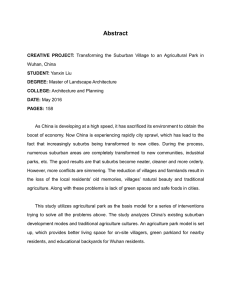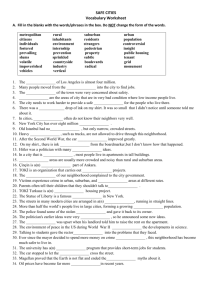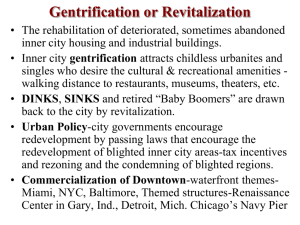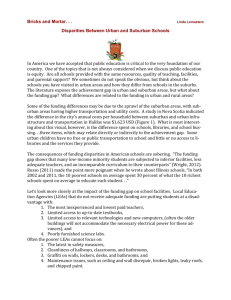FROM SEWERS TO SUBURBS Transforming the Policy-Making Context of American Cities RESEARCH NOTE
advertisement
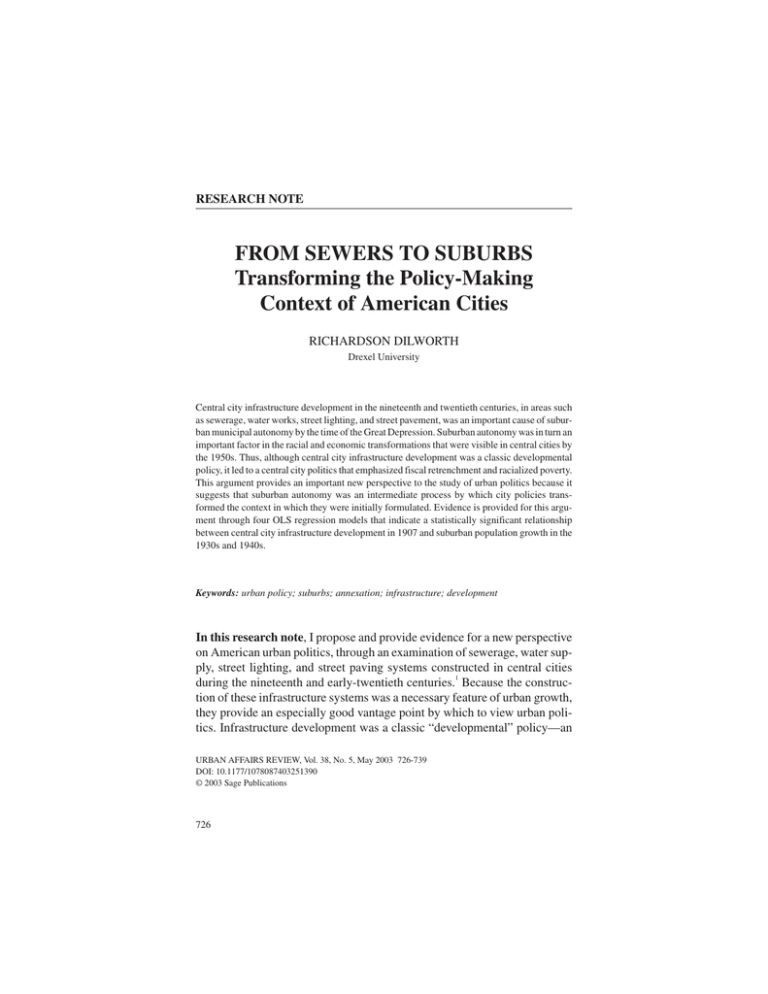
10.1177/1078087403251390 Dilworth / SEWERS TO SUBURBS URBAN AFFAIRS REVIEW / May 2003 ARTICLE RESEARCH NOTE FROM SEWERS TO SUBURBS Transforming the Policy-Making Context of American Cities RICHARDSON DILWORTH Drexel University Central city infrastructure development in the nineteenth and twentieth centuries, in areas such as sewerage, water works, street lighting, and street pavement, was an important cause of suburban municipal autonomy by the time of the Great Depression. Suburban autonomy was in turn an important factor in the racial and economic transformations that were visible in central cities by the 1950s. Thus, although central city infrastructure development was a classic developmental policy, it led to a central city politics that emphasized fiscal retrenchment and racialized poverty. This argument provides an important new perspective to the study of urban politics because it suggests that suburban autonomy was an intermediate process by which city policies transformed the context in which they were initially formulated. Evidence is provided for this argument through four OLS regression models that indicate a statistically significant relationship between central city infrastructure development in 1907 and suburban population growth in the 1930s and 1940s. Keywords: urban policy; suburbs; annexation; infrastructure; development In this research note, I propose and provide evidence for a new perspective on American urban politics, through an examination of sewerage, water supply, street lighting, and street paving systems constructed in central cities during the nineteenth and early-twentieth centuries.1 Because the construction of these infrastructure systems was a necessary feature of urban growth, they provide an especially good vantage point by which to view urban politics. Infrastructure development was a classic “developmental” policy—an URBAN AFFAIRS REVIEW, Vol. 38, No. 5, May 2003 726-739 DOI: 10.1177/1078087403251390 © 2003 Sage Publications 726 Dilworth / SEWERS TO SUBURBS 727 important tool that cities used to attract labor and capital (Kessides 1996; Aschauer 1989; Peterson 1981). Evidence presented here suggests, however, that central city infrastructure development also contributed inadvertently to the establishment of independent suburbs that had the capacity to become rivals to the central city. Cities competed for labor and capital through infrastructure development. At the same time, central city infrastructure development increased intercity competition by contributing to the development of independent, technologically advanced suburbs. Central city infrastructure development provided both the means and the motivation for surrounding suburbs to become (or, in other instances, remain) independent municipalities. An intimate relationship between central city infrastructure development and political corruption provided the motivation for suburban autonomy. New public works projects in cities made millions of dollars available to politicians, who used that money to build their power and enrich themselves through padded contracts, insider real estate deals, and other nefarious practices. For instance, each of the identifiable political “bosses” in three central cities in the New York metropolitan region in the nineteenth century—William Tweed in New York, William Bumsted in Jersey City, and James Smith, Jr. in Newark—put themselves personally in charge of the city agency that had responsibility for public works (Dilworth 2001). One result was that large infrastructure projects in cities were often accompanied by well-publicized political scandals. As cities then attempted to expand their borders by annexing outlying communities, they met resistance from suburbanites who did not want to be taxed at exorbitant levels to support what they viewed as venal political organizations. To return to the case of New York, in 1892 a local newspaper “solicited the opinions of prominent Flushing men” regarding the proposed annexation of that town to New York City, “and most disapproved of the plan. Foremost among their objections was their fear of Tammany” (Kroessler 1991, 240). Suburban infrastructure development provided the means for suburban autonomy. Central city infrastructure development facilitated suburban infrastructure development, and thus suburban autonomy, in at least two ways. First, engineers and contractors who had been trained on large infrastructure projects in central cities could sell their expertise to suburban communities that wanted infrastructure systems installed. A greater degree of infrastructure development in the city created a larger pool of experienced engineers and contractors, thus creating more competitive markets for expertise, which subsequently lowered the costs of suburban infrastructure development. Second, large public works projects in cities led to the technological advancement of infrastructure systems that decreased their costs, thus making them 728 URBAN AFFAIRS REVIEW / May 2003 available to smaller communities. As Paving and Municipal Engineering reported in 1890, the popularity of George Waring’s separated sewerage system was “due to its comparative cheapness, which is a distinctive merit, because it enables places to have the benefits of sewerage which would otherwise not have them” (The Waring system 1890, 4). In the same year, the journal also reported, There was a time when water-works plants were thought of as being desirable only for cities and towns of large growth, but now in every progressive community of any considerable number of people, water-works are being brought into use as a convenience, if not a necessity, . . . the reduction in the cost of plants, and the great improvement in the systems over all other kinds of water supply will make the business more general in the future. (Future of the water-works 1890, 26-27) Infrastructure development was of course not the only cause of suburban autonomy in the nineteenth and early-twentieth centuries. However, the hypothesized relationship between infrastructure development and suburban autonomy has several important implications for the study of urban politics. Most authors treat suburban autonomy as either an independent or exogenous variable: Regional inequality of local government resources is caused by suburban autonomy, or suburban autonomy provides the framework by which local government resources can be unequally distributed (Orfield 1997; Rusk 1995; Neiman 1982; Miller 1981; Hill 1974). In contrast, I treat suburban autonomy as an intermediary process that explains how central city government policies have transformed the context in which they are formulated. Central city infrastructure development that ostensibly benefited all city residents inadvertently facilitated economic sorting in metropolitan regions, in which some cities become middle- and upper-class enclaves, whereas others become repositories of the lower class. My thesis also reverses the traditional understanding between city politics and “the larger socioeconomic and political context” (Peterson 1981, 4). By arguing that infrastructure policies and politics within the central city played a significant factor in shaping the city’s geographic limits, I am suggesting that city politics had an important (albeit unintended) impact on at least part of the larger context—the metropolitan region—in which it took place. Finally, the connection between infrastructure development and suburban autonomy is relevant to the study of American political development because it suggests a process of path dependence between a technological field involving high fixed costs and the complex institutional arrangements that characterize metropolitan regions in the United States (cf. Pierson 2000). Dilworth / SEWERS TO SUBURBS POLITICAL MACHINES PERCEIVED LIKELIHOOD OF INCREASED TAXES ENGINEERING EXPERTISE CENTRAL CITY INFRASTRUCTURE DEVELOPMENT CONSTRUCTION EXPERIENCE 729 SUBURBAN AUTONOMY DECREASING COST OF INFRASTRUCTURE DEVELOPMENT TECHNOLOGICAL DEVELOPMENT OF INFRASTRUCTURE SYSTEMS Figure 1: Full Model of the Relationship Between Central City Infrastructure Development and Suburban Autonomy STATISTICAL EVIDENCE The preceding argument is summarized in Figure 1. This section describes evidence for the argument found through ordinary least squares (OLS) regression analysis. Four models all indicate a statistically and substantively significant relationship between central city infrastructure development and what I have called “suburban capacity” across the United States (Table 1). The evidence available at such an aggregate level is not sufficient to prove the argument correct. Figure 2 shows the relationship that can be tested through statistical analysis with the available data. Although the evidence is limited, it does provide an important basis for further research. The dependent variable, suburban capacity, refers to the extent to which suburban municipalities are capable of competing against the central city for labor and capital. Suburbs with more extensive infrastructure systems had a greater capacity to compete against the central city for labor and capital and were thus also more likely to remain independent of the central city. I argue that central city infrastructure development inadvertently facilitated suburban infrastructure development and thus suburban capacity. There should thus be a positive relationship between central city infrastructure development and suburban capacity. I measured suburban capacity in two ways: (1) population change within metropolitan districts (MDs), excluding central cities, between 1930 and 1940 (Table 1, models 1 and 3); and (2) population change within standard metropolitan areas (SMAs), excluding central cities, between 1940 and 1950 (Table 1, models 2 and 4). Ideally, earlier measures of suburban capacity would have been used. However, for the purposes of regression analysis, not enough MDs were measured by the Census Bureau before 1930. Although similar in practice, MDs and SMAs are not strictly comparable. MDs include 730 TABLE 1: Ordinary Least Squares Models Model 1 1930-1940 Independent Variable Intercept Persons per dwelling Persons per acre, 1907 Northeastern states Southern states Midwestern states Western states Per capita property tax, 1906 Brick and tile firms, 1900 Year of first incorporation Year water system was built/acquired Miles of unpaved streets, 1907 Central city population, 1907 Central city infrastructure development, 1907 Population inside city served by water system, 1915 Population outside city served by water system, 1915 2 Adjusted R N b Model 2 1940-1950 SE b –387669* 222482 2305 1767 972*** 336 –14477* 8238 –1544 9354 –14111* 8552 –8563 12396 407 620 380 451 5 74 196* 117 19** 9 –3* 2 NOTE: The dependent variable is suburban capacity. *p ≤ .10. **p ≤ .05. ***p ≤ .01. ****p ≤ .001. 3*** 1 Model 3 1930-1940 SE b 327854 468253 –3895 3550 –458 700 –53383*** 17865 –31593 19912 –55591*** 18488 –29476 25570 237 1306 134 976 95 158 –226 252 26 20 8** 4 6*** SE SE 681105 451763 –5958* 3523 –945 719 –77743**** 17325 –57221*** 19651 –82559**** 18282 –71165** 27558 1616 1245 2349** 996 109 157 –414* 246 21 20 –35* 20 2 –3 .89 83 b –208687 219767 1158 1836 732** 355 –24798*** 8260 –13258 9371 –26095*** 8635 –22939 14100 1325** 619 1405*** 475 3 75 108 116 16* 9 –18* 10 17** .62 78 Model 4 1940-1950 8 22 45*** 17 –1 46 .62 76 .89 82 Dilworth / SEWERS TO SUBURBS 731 PERCEIVED LIKELIHOOD OF HIGHER TAXES CENTRAL CITY INFRASTRUCTURE DEVELOPMENT SUBURBAN CAPACITY CONSTRUCTION EXPERIENCE (creates possible spurious association) Figure 2: Testable Relationship Between Central City Infrastructure Development and Suburban Capacity all contiguous “minor civil divisions or incorporated places having a population density of 150 or more per square mile,” whereas SMAs include entire counties that met somewhat different criteria (U.S. Bureau of the Census 1952, xxxiii-xxxv). Because the Census Bureau stopped using MDs, and began using SMAs, in 1940, changes in suburban capacity cannot be measured from the 1930s to the 1940s.2 Overall, MDs are probably a better measure of suburban capacity. While SMAs include low-density, unincorporated areas within otherwise urban counties, MDs include only outlying areas that meet population density requirements where infrastructure systems were probably a necessity. Moreover, the 1930s are closer to the time period of primary interest. However, suburban capacity in the 1940s provides an important comparison to the 1930s because the 1930s were an anomalous decade when urbanization was slowed by economic depression. The independent variable of primary interest, infrastructure development, is measured as the total miles of sewer pipe, water main, paved streets, and the total number of gas and electric street lights in central cities in 1907 (U.S Bureau of the Census 1910, 372-86, 458-69, 484-91). It was only in 1905 and 1907 that the Census Bureau provided data on cities’ water supply, sewerage, street lighting, and paving systems that were sufficient for regression analysis. The lack of data for other years precluded the use of time-series analysis, which is arguably a more appropriate method to use for testing the argument. Indeed, the lack of comparable data for years other than 1905 and 1907 precluded the measurement of infrastructure development in terms of growth because I considered a two-year time lag insufficient to meaningfully measure change. The most that can be said of the infrastructure development variable is that it measures the net cumulative growth of infrastructure systems within central cities, up to 1907. A city in 1907 with, say, an extensive sewerage system also tended to have an extensive water supply system, more paved streets, and more street lights—a fact reflected in bivariate Pearson correlations from .78 to .97 732 URBAN AFFAIRS REVIEW / May 2003 between all of these measures. For the sake of parsimony, it was desirable to create a general, comprehensive measure. Without any clear criteria for assigning relative degrees of importance to different types of infrastructure, simply summing the individual measures was the most straightforward approach. Two control variables intended to modify the infrastructure development variable were included in the models: (1) total miles of unpaved streets, to take into account the relative degree to which the city’s streets were paved; and (2) the year that a city’s water system was either built or acquired by the city, to control for temporal variations in water supply systems (U.S. Bureau of the Census 1910, 372-37, 484-91). Obviously, the available data for this analysis do not provide a perfect test of the argument. For instance, infrastructure development measured earlier than 1907 may have captured a greater level of variability between cities. However, given that the earliest possible date for measuring suburban capacity is 1930, earlier measures of infrastructure development would probably allow for too great a time lag between the dependent and independent variables. As it is, the time lag of more than two decades may be excessive. This latter problem is mitigated by the fact that the dependent variable is measured by population growth. At the levels of density measured by the Census Bureau (at least for MDs), suburban population growth was most likely preceded by suburban infrastructure development. Thus, suburban population growth should provide a measure of earlier infrastructure development. Regional dummy variables for cities in the northeastern, southern, midwestern and western United States were included in the models, with border states excluded to avoid perfect multicollinearity.3 I expected for a variety of reasons that the regional location of a city had an impact on infrastructure development. First, geological variations across regions may have affected the need for various types of infrastructure. A city might be blessed with natural drainage by its location in a mountainous region, for instance. Variations across regions in natural resources such as watersheds and coal deposits may have also had an important impact on water distribution and gas street lighting. Second, the political traditions and cultures of cities may have varied by region. Third, regional dummy variables should provide at least a partial control for state laws relating to municipal annexation, incorporation, and home rule. In short, regional dummy variables serve as efficient controls for a number of conceivable factors that are not of central interest in this analysis and that could not be adequately measured otherwise. Region is also a proxy measure for the age of a city (Liebert 1976, 49-51). Older cities in the Northeast and the Midwest conceivably had more extensive infrastructure systems simply because they had a longer time to build those systems. There are, of course, several conceivably more accurate Dilworth / SEWERS TO SUBURBS 733 measurements of city age than region, such as date of first incorporation or the date by which a certain population size was reached. Only date of first incorporation was included in the models presented here. Dummy variables for cohort cities that had reached populations of 10,000 by 1840, 1850, 1860, 1880, and 1890 were not statistically significant in earlier versions of the model and were excluded for the sake of parsimony.4 I have hypothesized that central city infrastructure development created more competition among contractors, thus lowering infrastructure development costs for the suburbs. However, local competitive markets among contractors may have had an independent impact on both cities and their suburbs, thus creating a spurious association between central city infrastructure development and suburban capacity. To control for this possibility, the number of brick and tile manufacturers per city in 1900 was included as an independent variable (U.S. Census Office 1902, 1046-47). Only one type of ostensibly relevant contractor was used as a proxy because this variable is highly correlated to variables using other types of contractors. All else being equal, the higher the cost of living or doing business in a city, the more demand there should be for land outside the city. Higher property taxes would have made a city more expensive and thus may have spurred suburban population growth. Higher population density may also have made living in a city more expensive by raising the price of housing. Two measures of density—average number of persons per acre and per dwelling, and per capita property taxes—were thus included as controls in the model (U.S. Bureau of the Census 1910, 131-32; 1908, 87-89, 198-203; U.S. Census Office 1902, clxi-clxiv). If the infrastructure development variable holds constant most of the improvements that would have come with higher property taxes, then per capita property taxes conceivably measure the level of government efficiency or, conversely, political corruption. In the model depicted in Figure 1, the perceived level of political corruption was identified as an intermediary variable between infrastructure development and suburban autonomy. Because I include both infrastructure development and property taxes as independent variables in the models, however, I do not account for the two-stage process depicted in Figure 1. Testing the full model depicted in Figure 1 would require a simultaneous equations model that is beyond the scope of this present article and the available data. Instead, by including property taxes in the models along with infrastructure development, I am making the assumption that property taxes in the central city also had some independent effect on suburban population growth. The final control variable included in the models was central city population size in 1907 (per 100 residents). Including population size as a control 734 URBAN AFFAIRS REVIEW / May 2003 served two purposes. First, because the model includes both population size and density, city land size is also controlled. A change in city population size with the number of people per acre held constant is also a change in city acreage. When included directly in the model, acreage created multicollinearity problems. However, because infrastructure development is measured by linear distance in the model, it is important to control for city land size. Second, controlling for city population size solves the conceivable problem that initial city size and later outlying growth may be correlated simply because different metropolitan areas are larger in scale than others. Including population size in the model also created multicollinearity problems because it is highly correlated with infrastructure development. However, because both population size and infrastructure development are statistically significant in the models, I considered this a reasonable trade-off. A final problem with the model is that cities with more extensive infrastructure systems in 1907 may have extended these systems into adjacent municipalities, without annexing them, to a greater extent by 1930. By measuring infrastructure development only within central cities, I may have simply drawn false boundaries on infrastructure systems that actually extended throughout the MDs, stimulating the development of land outside the city in a process other than what has been hypothesized here. Census data on cities’ water supply systems in 1915 provide for a partial test of the possibility that central city infrastructure systems extending into outlying communities explains suburban capacity. The census divided the populations served by cities’ water supply systems in 1915 into those who lived inside and those who lived outside the cities (U.S. Bureau of the Census 1916, 156-58). If suburban capacity were in part caused by city infrastructure systems that extended into new suburban communities, we would expect a significant and positive relationship between the number of people living outside a city but served by its water supply system in 1915 and suburban capacity. Thus, in two additional models, the population served by cities’ water supply systems living inside cities was used as a measure of infrastructure development, and the population served by city water systems living outside cities in 1915 was used as an additional control variable (Table 1, models 3 and 4).5 The four models are shown in Table 1. Detroit was removed from the data set as an outlier in all of the models. Suburban population growth around Detroit in both the 1930s and 1940s far exceeded that of other similarly sized cities, due most likely to the unique characteristics of the automotive industry. Other transformations of the data had no substantial effect on the results of the regression analysis. Dilworth / SEWERS TO SUBURBS 735 Models 1 and 2 indicate that the net cumulative growth of infrastructure systems within central cities up to 1907 is significantly and positively related to suburban capacity, or population growth in independent suburbs, in both the 1930s and 1940s. Models 3 and 4 indicate that the population living outside cities but served by city water systems in 1915 is not a statistically significant explanation of suburban capacity in the 1930s or 1940s, whereas the population served by these systems living inside cities is. Models 3 and 4 thus confirm the argument by indicating that it was specifically infrastructure development within cities in 1915 that contributed significantly to the size of populations living outside these cities after 1930. In all of the models, the statistical significance and the coefficients of the regional dummy variables indicate that the level of suburban population growth associated with infrastructure development was lowest in the Northeast and the Midwest and increased as one moved west and south. This suggests that the regional dummy variables control for temporal variation because conceivably suburban growth around the older cities of the Northeast and the Midwest had started and slowed earlier relative to other regions of the country by 1930. The lack of statistical significance of the date at which cities received their first corporate charters is probably due to the inability of this measure to adequately capture city age.6 The lack of statistical significance for brick and tile manufacturers in the model estimations using more accurate measures of infrastructure development (models 1 and 2) suggests that more competitive markets for contractors had no effect on suburban capacity independent of central city infrastructure development. Similarly, the lack of statistical significance in the case of property taxes suggests that high taxes and inefficiency on the part of a central city had no independent impact on suburban population growth. City land size, measured indirectly through density and population, is statistically significant in model 1 but not model 2. When city land size is statistically significant, both density and population become statistically significant, as in model 1. With density controlled, population becomes a measure of land size. With land size controlled, density becomes a measure of population. Thus, in Model 1 the negative relationship between population and suburban capacity reflects a negative relationship between city land size and outlying population growth (a geographically larger city takes up more space in an MD, thus reducing outlying population growth), and the positive relationship between density and population growth reflects a positive relationship between city population size and suburban population growth (a more populated city experiences greater suburban population growth; the MD is larger in scale). In model 2, density is no longer significant, and population therefore 736 URBAN AFFAIRS REVIEW / May 2003 no longer measures land size. Instead, population controls for the scale of the metropolitan region in model 2, as indicated by its positive relationship to suburban capacity. It is probably largely due to the change in measurement from MDs to SMAs that city land size loses its significance as an explanation of suburban capacity in the 1940s. Because SMAs include more land than MDs, population growth in SMAs has less to do with central city land size than population growth in MDs. However, the lack of significance of city land size in model 2 may also reflect changes in suburban population growth from the 1930s to the 1940s. With new federally subsidized housing developments linked to cities with new roads, and more cars, conceivably more people were locating outside of their respective cities in the 1940s. If it was no longer linked to city land size, suburban population growth in the 1940s was still clearly linked to earlier patterns of development within the central city. Indeed, central city infrastructure development in 1907 apparently had a greater impact on suburban capacity in the 1940s than in the 1930s. Among cities of the same size in 1907, 10 additional miles of paved streets, lit by 40 gas or electric lights, under which there were 10 miles of water mains and sewers, translates into an additional growth in suburban population of 210 people in the 1930s and an additional growth of 420 people in the 1940s. This difference may be due to at least two things: (1) Relative to infrastructure development, SMAs captured a larger though proportionately similar level of population growth in the 1940s than did MDs in the 1930s; and/or (2) relative to infrastructure development, suburban population growth in the 1940s was greater than in the 1930s though proportionately similar in both decades. If infrastructure development is linked to greater suburban capacity in the 1940s, this suggests that infrastructure development at the turn of the century has had a cumulative effect on metropolitan regions. Just as central city infrastructure development in the late nineteenth century could provide resources for new suburbs, suburban infrastructure development in the early-twentieth century could provide new resources for still newer suburbs. Thus, cities’ investments in their own infrastructure systems might translate into greater suburban growth decades later, and central city infrastructure development may define an important path-dependent process of urbanization that has been largely overlooked. The OLS models presented in this article demonstrate that there was a significant relationship between central city infrastructure development and suburban population growth. What this relationship means is, of course, open to speculation. I have hypothesized that central city infrastructure development lowered the costs of suburban infrastructure development, that these Dilworth / SEWERS TO SUBURBS 737 lower costs stimulated investments in infrastructure systems by suburban municipalities, and that this suburban infrastructure development was reflected in suburban population growth in the 1930s and 1940s. These points cannot be conclusively proven with the existing data on infrastructure development and the populations of MDs. Indeed, it is an unavoidable shortcoming of the analysis, due to lack of data for the time period in question, that unobserved variables are most likely partially responsible for both central city infrastructure development and suburban population growth. Differences in demand for workers, in productivity, or economic output within metropolitan regions would probably increase both infrastructure development in 1907 and suburban population growth in the 1930s and 1940s. Likewise, median family incomes within central cities or metropolitan regions overall would probably explain part of the demand for such modern luxuries as sewers and paved streets. To some extent, these unobserved variables are probably reflected in the control variables. For instance, central city population size and the number of brick and tile manufacturers per city probably reflect the overall productivity and demand for workers in metropolitan regions. Still, the most that can be said for the regression analysis presented here is that it has performed the necessary job of “clearing the brush” for more detailed studies of infrastructure development in metropolitan regions. Given the limitations of the available data, further research would most fruitfully take the form of case studies of metropolitan regions. CONCLUSION At the turn of the century, cities invested in infrastructure systems to meet the needs of their growing populations. In the laying of sewers, water mains, street pavements, gas and electric conduits, cities also served as springboards for population growth beyond their borders, thus placing them in a context of greater competition for labor, capital, and, in the case of annexation, land. Infrastructure systems developed in the context of earlier crises, such as fires and disease epidemics, became elements within a new urban crisis as businesses and residents left central cities for the outlying, independent suburbs. Of course, if cities had not developed their infrastructures, they would have faced worse crises than suburban flight. While infrastructure systems brought benefits to cities, they also had unintended consequences. Of course, all policies have unintended consequences. What makes the unintended consequences of central city infrastructure development interesting is that they point out a significant irony within American urban political development. If this irony can be found in city policies besides infrastructure 738 URBAN AFFAIRS REVIEW / May 2003 development, it could serve as the starting point for a theory of how city government policies transform the context in which cities operate. This article is at least a very small step in that direction. NOTES 1. For a historical overview of this process, see Tarr (1985) and Armstrong (1976). 2. In 1920, the U.S. Census Bureau measured metropolitan districts (MDs) for central cities with populations of more than 200,000; then in 1930, for central cities with populations of more than 100,000; and in 1940, for central cities with populations of more than 50,000. The numbers of MDs measured by the Census Bureau were 29 in 1920, 96 in 1930, and 140 in 1940. The MD populations used in this article come from the 1940 census, which used comparable 1930 and 1940 population figures for MDs as defined in 1940. The Census Bureau began to use standard metropolitan areas (SMAs) in 1950 but retroactively measured SMA populations in 1940 in the 1950 census. The suburban populations of both SMAs and MDs including more than one central city were divided between the central cities in proportion central city populations to make the measure comparable to the infrastructure development measure (U.S. Bureau of the Census 1923, 87-93; 1932, 77-79; 1942, 11, 58-60). 3. States counted as being in the Northeast are Connecticut, Maine, Massachusetts, New Hampshire, Rhode Island, Vermont, Delaware, New Jersey, New York, and Philadelphia; in the South: Alabama, Arkansas, Florida, Georgia, Louisiana, Mississippi, North Carolina, South Carolina, Tennessee, Texas, and Virginia; in the Midwest: Illinois, Indiana, Michigan, Ohio, Wisconsin, Iowa, Kansas, Minnesota, Nebraska, North Dakota, and South Dakota; in the West: Arizona, Colorado, Idaho, Montana, Nevada, New Mexico, Utah, Wyoming, California, Oregon, and Washington; and in the border states: Kentucky, Maryland, Missouri, Oklahoma, and West Virginia. 4. The city age dummy variables were tested in models that both included the regional dummy variables and those that did not. In both cases, they were not statistically significant at p ≤ .10. Because all of the central cities in the data set had populations of less than 30,000 in 1907, the threshold of 10,000 captured a good deal of variation in city age. 5. The Census Bureau’s 1915 report did not provide information on the privately owned and operated water supply systems that served 26% of the 204 cities with populations of more than 30,000 in 1915. When the data from the 1915 report were combined with the data set, however, the fact that only cities with municipal water systems were counted only eliminated two cities (Indianapolis and Denver), and I thus did not consider this a significant problem. Infrastructure systems owned by private companies (such as most gas and electric systems) may have been more likely to extend out into the independent suburbs. If this is true, it would confirm my general argument. Cities often granted franchises to several companies in an effort to create competition (in New York City, eight companies supplied electricity to street lamps by 1896). If this competition reduced the price of services, and if this reduction in price increased the likelihood that suburban municipalities would also use these utility companies, then metropolitan growth stimulated through the private provision of infrastructure operated in a fashion that agrees with the argument. 6. Even within states, the population level at which a settlement received a city charter could vary widely, and many settlements were incorporated as other types of municipalities (villages, boroughs, towns, etc.) before they became cities. Dilworth / SEWERS TO SUBURBS 739 REFERENCES Armstrong, E., ed. 1976. History of public works in the United States: 1776-1976. Chicago: American Public Works Association. Aschauer, D. A. 1989. Is public expenditure productive? Journal of Monetary Economics 23:177-200. Dilworth, R. 2001. Paving bodies politic: Government fragmentation and infrastructural development in the American metropolis. Ph.D. diss., Johns Hopkins University. Future of the water-works business. 1890. Paving and Municipal Engineering 1:26-27. Hill, R. C. 1974. Separate and unequal: Government inequality in the metropolis. American Political Science Review 68:1557-69. Kessides, C. 1996. A review of infrastructure’s impact on economic development. In Infrastructure and the complexity of economic development, edited by D. F. Batten and C. Karlsson. New York: Springer. Kroessler, J. A. 1991. Building Queens: The urbanization of New York’s largest borough. Ph.D. diss., City University of New York. Liebert, R. 1976. Disintegration and political action: The changing functions of city governments in America. New York: Academic Press. Miller, G. 1981. Cities by contract: The politics of municipal incorporation. Cambridge, MA: MIT Press. Neiman, M. 1982. An exploration into class clustering and local-government inequality. In Analyzing urban-service distributions, edited by R. C. Rich. Lexington, MA: Heath. Orfield, M. 1997. Metropolitics: A regional agenda for community and stability. Rev. ed. Washington, DC and Cambridge, MA: Brookings Institution Press and The Lincoln Institute of Land Policy. Peterson, P. E. 1981. City limits. Chicago: Univ. of Chicago Press. Pierson, P. 2000. Increasing returns, path dependence, and the study of politics. American Political Science Review 94:251-68. Rusk, D. 1995. Cities without suburbs. 2d ed. Washington, DC: Woodrow Wilson Center Press. Tarr, J. A. 1985. Building the urban infrastructure in the nineteenth century: An introduction. In Infrastructure and urban growth in the nineteenth century. Chicago: Public Works Historical Society. U.S. Bureau of the Census. 1908. Statistics of cities having a population of over 30,000: 1906. Washington, DC: Government Printing Office. . 1910. Statistics of cities having a population of over 30,000: 1907. Washington, DC: Government Printing Office. . 1916. General statistics of cities: 1915. Washington, DC: Government Printing Office. . 1923. Abstract of the fourteenth census of the United States: 1920. Washington, DC: Government Printing Office. . 1932. Abstract of the fifteenth census. Washington, DC: Government Printing Office. . 1942. Sixteenth census of the United States: 1940, population. Vol. 1. Washington, DC: Government Printing Office. . 1952. Census of population: 1950, number of inhabitants. Vol. 1. Washington, DC: Government Printing Office. U.S. Census Office. 1902. Twelfth census, volume 8. Manufactures: States and territories, part II. Washington, DC: U.S. Census Office. The Waring system of sewerage. 1890. Paving and Municipal Engineering 1:4. Richardson Dilworth is an assistant professor of politics at Drexel University.
